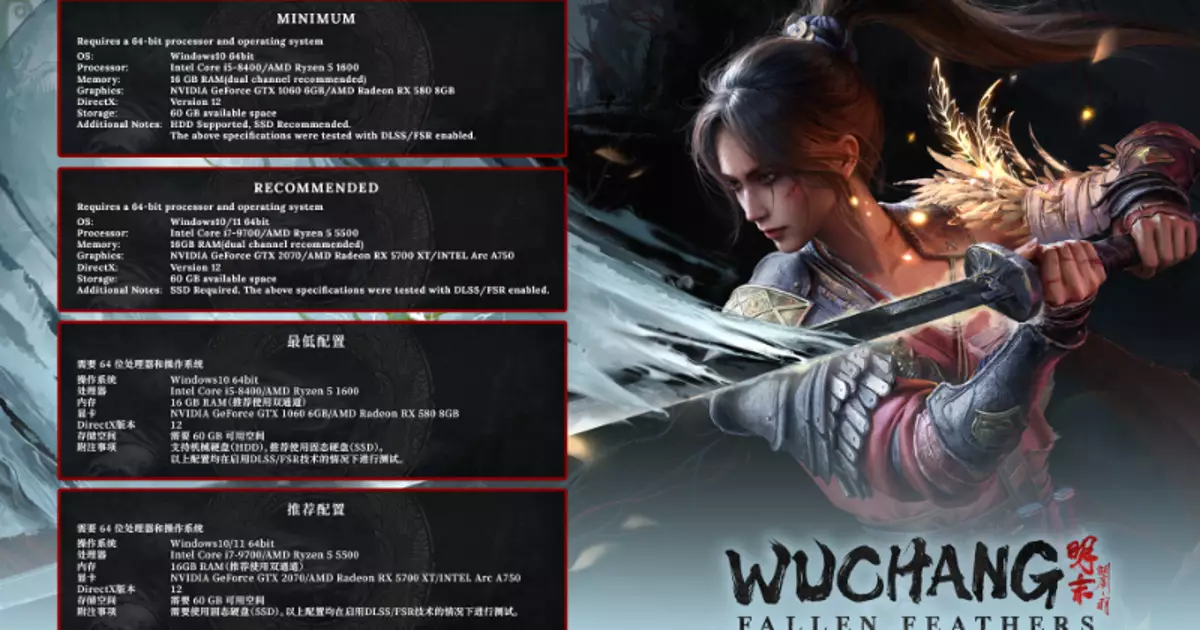Wuchang: Fallen Feathers emerges as an ambitious action-RPG that promises to push the boundaries of traditional Chinese mythology intertwined with dark fantasy elements. Unlike its humble past in 2021, where it was vaguely compared to Bloodborne for its gritty atmosphere and challenging gameplay, recent updates suggest a more refined and visually distinct experience. The developers, Leenzee, have paid close attention to visual fidelity, subtly shifting away from the overwhelmingly red hues that once painted Shu—a plague-ridden, feathered dystopia—to a more immersive, atmospheric world. This indicates a deliberate effort to craft an environment that is both haunting and artistically compelling, inviting players to get lost in its layered storytelling and foreboding landscapes.
What makes Wuchang stand out is its audacious premise: a protagonist trapped in the turbulent era of the Ming dynasty, entangled in a supernatural affliction that grants and curses her with feathers. The game’s blending of period-specific aesthetics with monstrous, plague-based transformations offers a fresh take on the traditional Chinese wuxia genre. Instead of simply battling human enemies or mythical beasts, players face off against corrupted winged abominations, fostering a sense of urgency and moral ambiguity. The narrative invites players to navigate complex alliances and unravel secrets buried in Wuchang’s lost memories while confronting the terrifying Feathering epidemic—an allegorical layer that echoes contemporary fears about disease and transformation.
Gameplay Depth and System Requirements: A Reflection of Its Ambitious Scope
From a technical perspective, Wuchang’s system requirements signal a game designed to deliver rich visuals without demanding cutting-edge hardware. The specifications—a modest Intel Core i5-8400 or AMD Ryzen 5 1600, paired with a GTX 1060 or Radeon RX 580—are approachable for most mid-tier gamers. Requiring 16GB of RAM and 60GB of SSD storage indicates an emphasis on smooth, responsive gameplay and high-quality assets. This balance suggests the developers aim to attract a broad demographic, ensuring players don’t need top-tier gear to experience Wuchang’s detailed combat and atmospheric storytelling.
On the recommended side, hardware leaps to an Intel Core i7-9700 or Ryzen 5 5500 and a GPU like the RTX 2070 or Radeon RX 5700 XT, highlighting the game’s potential for stunning visual effects such as dynamic lighting, intricate particle systems, and nuanced character models. The mention of DLSS 4, Nvidia’s AI-powered rendering technology, is particularly noteworthy, promising enhanced performance and fidelity—crucial for maintaining immersion during intense boss battles or exploration sequences.
While the requirements are accessible, they clearly aim to maximize visual potential, reinforcing the game’s narrative depth and visceral combat mechanics. The utilization of such hardware-driven features underscores a push towards high-quality, immersive experience that balances accessibility with visual excellence.
Gameplay Mechanics and Narrative Choices: A Promising Mythic Adventure
Playing as Wuchang, players are thrust into a narrative-rich world where decisions carry weight. The game’s emphasis on branching outcomes—encouraged through the collection of secrets, alliances, and combat choices—aims to foster replayability and personal investment. The incorporation of “Red Mercury” for unlocking new techniques and enchanting weapons hints at a layered upgrade system that rewards tactical experimentation. It’s a clear signal that Wuchang isn’t just about mindless slaughter but about strategic mastery and character customization.
Themes of identity and memory serve as core pillars of the story, with the protagonist’s journey reflecting universal struggles of self-discovery amid chaos. The feathered plague acts both as a literal threat and as a metaphor for loss, transformation, and the fear of losing oneself to external forces. The game’s narrative design seems poised to balance intense combat sequences with moments of introspection, giving rise to a complex universe where every choice influences which ending you receive.
That said, the devil is in the details. The comparison to Bloodborne isn’t accidental—Wuchang seems to embrace the challenge and dark aesthetic of From Software’s masterpiece, but with a distinctive Chinese cultural sensibility. The monstrous boss fights, the upgrade paths, and the emphasis on exploration signal a game tailored for players craving intricate combat intertwined with rich lore.
Final Thoughts: The Promise of a Unique, High-Impact Experience
Wuchang’s rise from an enigmatic concept to a full-fledged game invites curiosity and anticipation. Its promise of a visually compelling, narratively nuanced, and mechanically rich experience positions it as a notable contender in the action-RPG genre. The careful balance the developers strike—making the game accessible hardware-wise while pushing its visual boundaries—demonstrates a mature design philosophy. If Wuchang lives up to its potential, it might redefine how myth, history, and grotesque fantasy coalesce in games rooted in Chinese heritage.
The integration of modern graphics technology, coupled with a deep, choice-driven narrative, suggests a game that seeks to satisfy both aesthetic sensibilities and gameplay depth. Wuchang offers more than just a bloody, feathered apocalypse; it offers a layered mythic tapestry woven with innovation and cultural richness. Whether it will soar like the albatross or falter under high expectations remains to be seen, but its bold vision alone guarantees that it will be a title worth tracking in the months to come.

